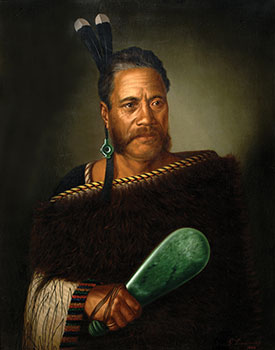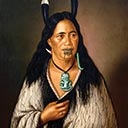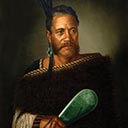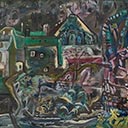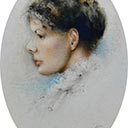Chief Ngatai - Raure
85 x 66.5 cm
Provenance: Private Collection, Auckland p. 16 & 17 NZ Early & Rare, International Art Centre, Auckland, 1972
Chieftain Ngatai - Raure is emblematic of Lindauer's practice: not only has the artist succeeded in conveying a sense of the sitter's reverential grandeur and chiefly status, but also in expressing his humanity and individuality. The penetrating expressiveness of Ngatai's gaze which extends beyond the confines of the painted dimension seems to wholly encapsulate this. This work and its companion portrait are understood to depict two members of the Ngatai family of Tauranga, who are related to Chief Hori Ngatai of the Ngaiterangi tribe. Chief Hori was a distinguished warrior and leader who helped defeat the British at Gate Pa in April 1864, and later went on to establish a marae at Whareroa. The acknowledgement of this familial link is not only genealogically relevant, but also symbolically so, for it places the work within a broader artistic and cultural context: Firstly, the portrait's existence within the artistic tradition of recording, celebrating and seeking to understand Maori community and culture is significant. Auckland Art Gallery's 2016 exhibition The Maori Portraits: Gottfried Lindauer's New Zealand comprised a formidable showcase to this effect - one in which the breadth and excellence of the artist's Maori portraits were presented on an unprecedented scale. Collectively, these works comprised a tour de force, affirming Lindauer's portraiture as an artistic tradition and cultural watershed. Chieftain Ngatai - Raure resonates as a splendid work in its own right,one which exists within a narrative of importance to our national cultural and artistic history. Trained in the 19th century European school of painting, (Vienna Academy of Fine Arts), Gottfried Lindauer brought a degree of painterly formalism to his portraits of Maori. Stylistically speaking, this work alignes to the tradition of classical portraiture. As is typical of this style, the composition of the portrait is without embellishment or adornment (Ngatai has been depicted against a neutral, studio-like backdrop). Symbolic elements such as the intricatelycrafted mere and the magnificent pounamu earring serve to affirm the sitter's status and provide further clues to his identity.
For more information on this piece, please download this PDF (45KB)

